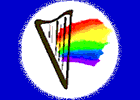














|
The Rediscovery of Carolan*
(Abridged) by Gráinne Yeats [Click here for full text] Turlough Carolan (1670-1738) was the last of a long line of Irish harper-composers. His music was played only by a few fellow harpers until the end of the 18th century, yet 200 years after his death, there came a sudden revival in his reputation. How did this all come about? Carolan was the inheritor of an ancient tradition. The harp in some form or other has been played in Ireland for two thousand years or so. It is one of the oldest instruments in the world, and it is by no means uniquely Irish. However, we Irish developed a kind of harp, and a special technique, which were unique and which made Irish harpers famous in medieval times. |
 Detail from "A Portrait of Carolan" by J.C.Timbrell, 1844. Click on image to view full portait. |
|
The Irish made a strong harp strung with brass wire, and they played it with long crooked fingernails. The sound produced is quite unlike any other instrument. It is sweet and clear, resonant and strong, and often resembles a peal of bells. The Irish harpers were the musicians of the aristocracy, maintained by the kings, the chiefs, and the powerful families. In later centuries, however, as Norman and English invaders gradually took over the country, they lost their protectors. It was presumably because of their importance in Gaelic society that the harpers were looked upon with suspicion by successive English governments, and numerous laws were brought in to proscribe them. In 1366, for example, all harpers were expelled from the area around Dublin, because these "Irish minstrels coming among the English, spy out the secrets, customs and policies of the English." Anyone who gave a harper hospitality would be imprisoned, as well as the harper, whose instrument would be forfeited to the king. At age 18 Carolan, from County Meath, was stricken with smallpox and was blinded. He decided to become a harper, and after three years study began his professional life, having been provided by his patron, Mrs McDermott Roe, with a horse, some money, and a guide. And so he embarked on a lifetime of travel, playing the music he had learned orally, as well as his own compositions. Despite the dismal political conditions and the oppresson of his own people, Carolan went on to lead a successful life, write new and individual music, and be welcomed by all. He became popular and famous during his lifetime, yet by the end of the 18th century his music had largely gone from the oral tradition, as a result of the disappearance of the traditional harpers. Other musicians had never looked on Carolan as one of their own, and did not play his music. It would be fair to say that, although his tunes existed in rare printed collections or manuscripts, until comparitively recently very few of them had been heard even by the Irish public, let alone by anybody else. Forty years ago, in sharp contrast with the present, Irish traditional music had only a small listening public. The music of the harp was hardly heard at all, and to most people the Irish harp seemed a somewhat exotic instrument. Nowadays things have changed, for there has been a general upsurge of interest in folk music. An important influence in this development was the work done in traditional music by Seán Ó Riada, a composer and Professor of Irish Music in University College, Cork. O Riada arranged some sweeping Irish melodies for two documentary films, and founded a group 'Ceoltóirí Cualann' in which he used the harpsichord in place of a traditional wire strung harp, which had fallen into disuse. I myself had spent fruitless years trying to persuade somebody to make one for me, but without success. The Group played to large and enthusiastic audiences in Ireland and internationally. Others learned the tunes, reestablishing the cycle of oral tradition, and now musicians all over the world learn Irish music. Included in Ceoltoiri Cualann's repertoire was music by Carolan and other harpers. About 200 Carolan pieces in fact survive, some in folk style or in traditional harp idiom, but most are in baroque style.
I remember once, appearing with the Chieftains at a Festival concert and leading a performance of 'Lord Inchiquin". This is a very good example of Carolan's baroque style, an elegant tune full of sequences and imitations, so I performed it with plenty of dynamics and rubato. Then the Chieftains followed, playing it at strict time at twice my speed, full of spirit and energy. I felt that both my quiet interpretation and their bright one were wholly valid. It is these contrasting styles that make his music so attractive to musicians of all kinds and styles. Who knows what he would have thought of all this - but it is easy to see him in his little house in Mohill, County Leitrim, enjoying the comfort of a good income and drinking a toast to the continuing popularity of his music. *This is the correct English-language version of the name, as used by Carolan himself, his friends and fellow harpers. |
| [To author biography] | [To full text] | [Back to top of page] |
Historical Harp | Folk and World Harp | Pedal Harp |
Harp Building | Harp Works | Non-Harps |
Camps & Concerts | Links | Glossary |
Donate! | Get Involved! | Contact Us | About Harp Spectrum
Copyright 2002 - 2017, Harp Spectrum All Rights Reserved